Laboratory in space: interview with Bernardo Patti Understand article
Bernardo Patti is the Columbus mission manager at the European Space Agency. He is an engineer and worked at nuclear power plants before going into space technology. Shortly before Columbus was launched, he talked to Anna-Lynn Wegener.
What is Columbus?
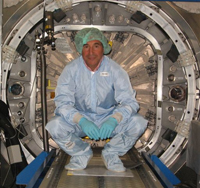
Columbus is the name of a research laboratory that we will send into space to dock with the International Space Station [ISS]w1. It is an add-on module to the station, that contains all the facilities to carry out experiments in space. It will be on board the Space Shuttle Atlantis, which will be launched in early 2008 from the Kennedy Space Center in Florida.
What does such a space laboratory look like?
Columbus has a cylindrical shape. It is around 7 metres long and 4.5 metres in diameter. Equipment inside is packed very efficiently.
We had to work very hard to come up with the best design that would make the most efficient use of the 75 m3 volume. It can now fit three crew members and contains all the essential research equipment. The individual research facilities accommodate very high-tech racks with drawers of equipment and workspace that can be pulled out.
What kind of research will be done with Columbus?
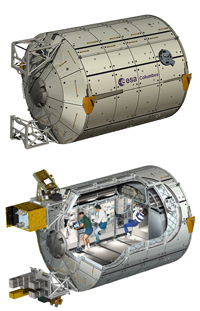
Columbus is a multidisciplinary laboratory. It contains four different facilities to carry out experiments in material science, fluid science and life science. In all of these fields we want to study the effect of weightlessness on different samples that we are sending from Earth.
Biolab, for example, is a facility for biological experiments on micro-organisms, cells, tissues, small plants and invertebrates. We want to find out what effect gravity – and the lack of it – has on all levels of living organisms. One of the first experiments we will do within Biolab is to observe how the roots of a small plant – you can imagine it a bit like rocket [rucola] – will grow. Will they grow up, down or in a completely different direction when not guided by gravity?
In the European Physiology Module contained in Columbus, the effect of long-duration spaceflights on the human body and health will be tested. We also hope to gain some insights into terrestrial problems such as the processes of ageing, balance disorders, bone osteoporosis and muscle dystrophy.
The Fluid Science Laboratory will hopefully reveal dynamics of fluids that cannot be studied on Earth, because they are masked by gravity and its effects. We will be looking at, among others, phenomena like flows and instabilities induced by surface tension gradients and thermal radiation forces, instabilities related to coupling between heat and mass transfer, thermo-physical properties of fluids, mechanisms of boiling and critical point phenomena.
In the Material Science Laboratory, experiments will be run to explore different materials to improve the study of their properties. We will melt and solidify metals and expose them to different atmospheres and conditions.
Isn’t it a lot of effort to send terrestrial samples into space to study them?
It definitely is a lot of effort, but it is worth it. All of the questions we are investigating could never be addressed in laboratories on Earth, because gravity is such a pervasive force on our planet. I know it sounds paradoxical that it is easier to understand some terrestrial phenomena in space, far away from their natural context, but gravity makes some experiments simply impossible and overrides many small effects that can be studied in orbit.
What are the challenges of a mission like Columbus?
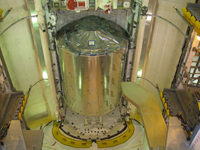
The foremost challenge was constructing a laboratory that on Earth would weigh at least 50 tonnes with a diameter of just over four metres while keeping it light enough to be sent into space. Columbus weighs around 12 tonnes and that is about the maximum weight the Atlantis shuttle can carry.
On Columbus we have been able to provide an environment where the crew can work in comfortable surroundings. Apart from this it is able to accommodate all the scientific facilities in the pressurised space. It can operate for 10 years in orbit. Unlike a ship that needs to be dry docked and then repaired, Columbus will have the capability to automatically detect any failures and to start self-repairing while still being operational. The entire European structure can be operational with just a single launch.
What excites you personally about the project?
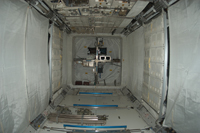
As an engineer, I was particularly attracted by the design and engineering challenges involved. But space and weightlessness also carry an inherent fascination: engineering and travelling into space share the fact that they overcome traditional barriers of technology and mankind. It is incredibly exciting and a huge step for space exploration.
On a more day-to-day basis, what I really love about the project is its internationality. The International Space Station is a collaborative project of five different space agencies. Apart from the European Space Agency (ESA), which by itself has 17 European member states, the US National Aeronautics and Space Administration (NASA) and the Canadian, Russian and Japanese space agencies are also involved.
Everyday I talk to people from many different countries, sometimes speaking several languages a day. It is rewarding for us to see so many nations putting so much effort into the realisation of such an ambitious project and to see healthy competition developing between nations.
Curiosity and science go beyond national borders and historic differences. They are strong, uniting forces that bridge geographical and cultural gaps.
Is there any way that teachers and school kids can benefit from Columbus?
At the moment we are focusing on getting Columbus safely up to the ISS and the first periods will be dedicated to setting it up and running experiments. But it might well be that in future we will broadcast lessons from or involving the Columbus module, just as has been done from the ISS [see the Resources section]. Columbus opens up countless new possibilities, some of which I am sure we cannot even conceive yet.
As we go to press: the Columbus module has joined the ISS
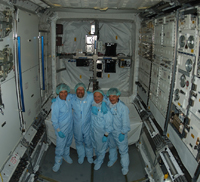
Atlantis safely returned to Earth with its crew of seven on 20 February, after spending almost 13 days in space, including nine days docked to the ISS, to deliver Europe’s first permanent human outpost in orbit. Two ESA astronauts, Hans Schlegel of Germany and Léopold Eyharts of France, travelled to the ISS; Schlegel returned to Earth with Atlantis but Eyharts became part of the resident ISS crew and will return to Earth in late March after performing a series of experiments, both in the laboratory and in the other science facilities already operating in the Station.
ESA will continue to contribute to ISS operations by launching unmanned Automated Transfer Vehicles (ATVs), designed to deliver scientific experiments, crew support equipment (such as food and clothing), fluids and propellant. The first ATV, Jules Verne, will be launched by an Ariane 5 rocket on 8 March.w2
As Columbus comes to life, so too does the network of nine User Support and Operations Centres (USOCs) throughout Europe, which facilitate the interface between researchers and the science payloads on board, and allow investigators to control their experiments and receive real-time data on their results. As more science payloads are delivered to Columbus by upcoming logistics missions, the USOC network will become more active.
Columbus was designed to support some 500 experiments per year for ten years, in cell and plant biology, astrobiology, human physiology, fluid and material sciences, fundamental physics, astronomy, remote sensing and technology. For the European science community and industrial R&D, a new era of research has just begun.
Web References
- w1 – An article about the International Space Station will be available in a future issue of Science in School. Keep visiting www.scienceinschool.org
- w2 – For more information about the Automated Transfer Vehicles, see the following article in this issue of Science in School:
- Williams A (2008) The Automated Transfer Vehicle – supporting Europe in space. Science in School 8: 14-20.
Resources
- ESA have produced many educational materials relating to the International Space Station (ISS):
- A printed ISS education kit for both primary- and secondary-school teachers is available in all 12 ESA languages. The kits are based on all the fascinating activities involved in building, working and living on board the ISS, and provide background information and exercises for classroom teaching. They are available to all school teachers in ESA member states and can be ordered free online: www.esa.int/spaceflight/education
- An interactive version of the ISS education kit is available here: www.esa.int/spaceflight/education
- A series of ISS DVD lessons cover topics relating to European school curricula. One about the Automated Tranfer vehicle is due to be released in summer 2008. The DVDs can be ordered free by teachers: www.esa.int/spaceflight/education
- ESA is also developing a series of online lessons for primary- and secondary-school students and their teachers. See: www.esa.int/SPECIALS/Lessons_online
- Further details and education materials can be found on the:
- European Space Agency Education website: www.esa.int/esaED/
- and the European Space Agency Human Spaceflight Education website: www.esa.int/esaHS/education.html
Institutions
Review
This article could start wonderful discussions about gravity, microgravity or free-fall conditions, how gravity on Earth affects chemical and physical behaviour of substances and bodies in Earth-based experiments, and how we can reproduce an almost gravity-free environment orbiting the Earth. The so-called Einstein equivalence principle immediately comes to mind, prompting one to wonder how free-fall can be equivalent to the absence of gravitational pull. Human body behaviour in space and after re-entering a terrestrial environment can involve life science and chemistry in an amazing interdisciplinary space party.
Marco Nicolini, Italy





